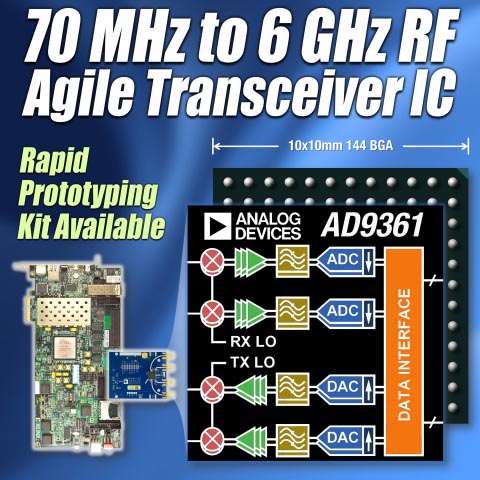-
- RF Agile Transceiver provides up to three times the noise performance of competition and significantly reduces BOM cost.
- Design kit, FPGA rapid prototyping environment reduce design times and risk.
Analog Devices introduced a revolutionary solution for software defined radio (SDR) applications. Designed to enable programmable radio applications that operate over a wide range of modulation schemes and network specifications such as defense electronics, instrumentation equipment and communications infrastructure, the new AD9361 RF Agile Transceiver achieves best-in-class performance, high integration, wideband operation and flexibility. The AD9361 is supported by a wide range of design resources to expedite time to market including a software design kit and FPGA mezzanine card (FMC) to rapidly develop software defined radio solutions.

"The AD9361 Agile Transceiver is a complete RF transceiver solution on a single chip – it’s an RF architect’s dream device," said Matt Ettus, President of Ettus Research™, a National Instruments Company. "We combined the AD9361, with a Xilinx Spartan-6 FPGA, USB 3.0 interface and comprehensive software support, to create one of the industry’s easiest-to-use and most flexible software-defined radio solutions."

The AD-FMCOMMS2-EBZ-FMC board provides designers with a rapid prototyping environment that supports multiple communications protocols, including most licensed and unlicensed bands.
About the AD9361 RF Agile Transceiver
Operating over a frequency range of 70 MHz to 6 GHz, the AD9361 is a complete radio design that combines multiple functions in a single chip. The RF agile transceivers integrate an RF front end, flexible mixed-signal baseband section, frequency synthesizers, two analog-to-digital converters and two direct conversion receivers to simplify design and reduce bill of material cost. The AD9361 supports channel bandwidth from less than 200 kHz to 56 MHz, and is highly programmable, offering the widest dynamic range available in the market today.
Two independent direct conversion receivers have a state-of-the-art noise figure and linearity. Each receive subsystem includes independent automatic gain control, dc offset correction, quadrature correction, and digital filtering, eliminating the need for these functions in the digital baseband. The AD9361 also has flexible manual gain modes that can be externally controlled.
Two high-dynamic-range A/D converters per channel digitize the received I and Q signals and pass them through configurable decimation filters and 128-tap FIR filters to produce a 12-bit output signal at the appropriate sample rate. The transmitters use a direct conversion architecture that achieves high modulation accuracy with ultra-low noise.
 |
| AD9361 Functional Block Diagram |
AD9361 Design Resources Available: Software Design Kit and FMC Board
Together with the FPGA mezzanine cards, ADI offers a wide range of AD9361 design resources including Gerber files, code references, Linux sample applications and drivers, and design support packages, which are available for download.
|
Part Number
|
Sample
Availability |
Production
Availability |
Price Each
in 1,000 Units |
Package
|
|
AD9361
|
Now
|
Now
|
$175
|
10-mm × 10-mm 144-ball CSPBGA
|
|
AD-FMCOMMS2-EBZ FMC Board
|
Now
|
Now
|
$750
|
Rapid Prototyping System
|
